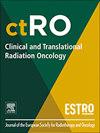Letter to the Editor: Reply to Topkan et al
IF 2.7
3区 医学
Q3 ONCOLOGY
引用次数: 0
Abstract
We thank the colleagues Topkan and the co-authors for their valuable comments on our study. As they stated correctly, there for sure are more factors influencing the development of necrosis – nicotine and alcohol might also play an important role, for example. Also some hints point at the distance of the catheters being associated with risk of necrosis. Due to the fact that the risk factors influence each other in their effect on the risk of necrosis and usually have an additive effect and due to the generally retrospective data collections in published articles on interventional radiotherapy in the oral cavity, some risk factors for late side effects cannot be perfectly recorded and evaluated. In our understanding, not only the distance to the mandible, but also the bone volume which is affected by radiation dose must be considered. No specific dose constraints exist for the mandible when applying interventional radiotherapy. We are currently analyzing further dose parameters available within CT-based planning workflows and hope for more detailed information on how we can improve the implants. Nevertheless, prospective data is needed to sufficiently address toxicity issues in a larger cohort of patients with long-term follow-up. As far as the disease-free survival is concerned, we indeed estimated this according to the current practice in several other published data without taking the event of death into account. This is obvious when looking at our results. Still, we agree that the different ways of presenting freedom of recurrence throughout the literature makes comparison rather difficult and should be unified. We thank you for your remark and will consider this in our future work.
给编辑的信:回复Topkan等人
我们感谢同事Topkan和共同作者对我们研究的宝贵意见。正如他们所说的那样,肯定有更多的因素影响坏死的发展,例如尼古丁和酒精也可能起重要作用。也有迹象表明导管的距离与坏死的风险有关。由于危险因素对坏死风险的影响是相互影响的,通常具有叠加效应,并且由于已发表的有关口腔介入放疗的文献资料收集一般为回顾性的,因此一些导致晚期副作用的危险因素无法得到完善的记录和评价。在我们的理解中,不仅要考虑到与下颌骨的距离,还要考虑到受辐射剂量影响的骨体积。介入放疗对下颌骨不存在特定的剂量限制。我们目前正在进一步分析基于ct的计划工作流程中可用的剂量参数,并希望获得有关如何改进植入物的更详细信息。然而,需要前瞻性数据来充分解决长期随访的更大患者队列中的毒性问题。就无病生存而言,我们确实是根据其他几个已发表的数据中目前的做法来估计的,没有考虑死亡事件。看看我们的结果,这一点很明显。尽管如此,我们一致认为,在整个文献中呈现递归自由的不同方式使得比较相当困难,应该统一。我们感谢你的评论,并将在我们今后的工作中考虑这一点。
本文章由计算机程序翻译,如有差异,请以英文原文为准。
求助全文
约1分钟内获得全文
求助全文
来源期刊

Clinical and Translational Radiation Oncology
Medicine-Radiology, Nuclear Medicine and Imaging
CiteScore
5.30
自引率
3.20%
发文量
114
审稿时长
40 days
 求助内容:
求助内容: 应助结果提醒方式:
应助结果提醒方式:


